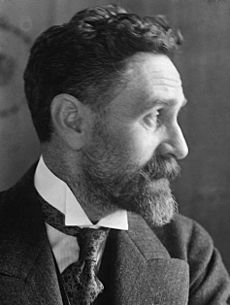Black Diaries facts for kids
The Black Diaries are a set of journals believed to have been written by the Irish revolutionary Roger Casement. These diaries cover parts of the years 1903, 1910, and 1911. They were found by authorities in April 1916 after Casement's capture. The diaries became a major topic of discussion and disagreement, especially during a difficult time for Casement. Many people debated whether the diaries were real or if they had been faked to harm his reputation. This debate has continued for many years, making the Black Diaries a famous mystery in history.
Contents
The Mystery of the Black Diaries
The name Black Diaries was first used by Peter Singleton-Gates and Maurice Girodias in their 1959 book. Roger Casement also kept other journals, like the ones from 1910, which are known as the White Diaries or Amazon Journal.
Early Doubts and Claims
The discussion about whether the Black Diaries were real began in 1936. A writer named William J. Maloney published a book called The Forged Casement Diaries. In his book, Maloney claimed that the British authorities had created the diaries. He suggested they did this to make Casement look bad. Maloney thought that parts of the diaries might have been copied from another person's journal that Casement had looked at during an investigation in Peru in 1911.
This idea that the diaries might be fake caught the attention of many people. The famous poet W. B. Yeats even wrote a poem called "Roger Casement" because of Maloney's book. Another poet, Alfred Noyes, who had once believed the diaries were real, later changed his mind. In 1957, Noyes wrote a book criticizing how the diaries were used.
Diaries Become Public
In 1959, Peter Singleton-Gates and Maurice Girodias published their own version of the diaries. They did this in Paris to avoid certain laws in Britain. They said their book was based on documents given to Singleton-Gates by an important person. Around the same time, the British government made the diaries available to the public. They could be seen at the Public Record Office in London.
After the diaries became public, the debate continued. In 1960, Roger McHugh pointed out some things that made him doubt the diaries were real. He noted "suspicious internal discrepancies" and changes in how the diaries looked over time.
Handwriting and Language Analysis
Experts have studied the Black Diaries closely to try and solve the mystery.
Handwriting Examinations
In 1993, a government expert named Dr. David Baxendale looked at the handwriting. He stated that "the bulk of the handwriting in there is the work of Roger Casement." He also said that any added parts matched Casement's handwriting.
Later, around the year 2000, another detailed forensic examination was done. Audrey Giles, a leading handwriting expert, examined the documents. Her report, published in 2005 by the Royal Irish Academy, concluded that "the handwriting, ink, paper, pen strokes and pencillings were all genuine."
However, two other forensic experts from the U.S. later reviewed Giles's report. Both were critical of it. James Horan said the report didn't clearly show how its conclusions were reached. Marcel Matley stated that the report didn't prove the writing was Casement's, even if the documents themselves were authentic.
Word Use and Historical Details
In 1994, Eoin O'Máille tried to analyze the words used in both the White and Black Diaries. He wanted to see if the Black Diaries were written by Casement. However, his method was criticized for using a program meant for checking the "reading age" of schoolchildren.
In 2002, Professor Daniel Vangroenweghe, a historian of the Congo Free State, examined Casement's time there. He argued that some of the slang words and details about people and places in the 1903 diary could not have been known in London in 1916. He also quoted from the unpublished writings of John Harris, who saw the diary in 1916. Harris initially doubted the diary but then found details only he and Casement would know, which shook his confidence.
Ongoing Debate
The debate about the Black Diaries continues even today. In 2016, Angus Mitchell published 16 Lives: Roger Casement, where he continued to argue that the diaries were forgeries.
Also in 2016, Paul Hyde's study from the University of Notre Dame concluded that neither side of the debate has fully proven their case. He noted that the "official" theory of the diaries being authentic "has almost no explanatory power whatsoever." He also stated that those who believe the diaries are forged do not have their belief supported by facts "beyond reasonable doubt."
All the diaries were published by Jeffrey Dudgeon in 2016, with an extended edition released later that year. The mystery of the Black Diaries remains a fascinating part of history.


